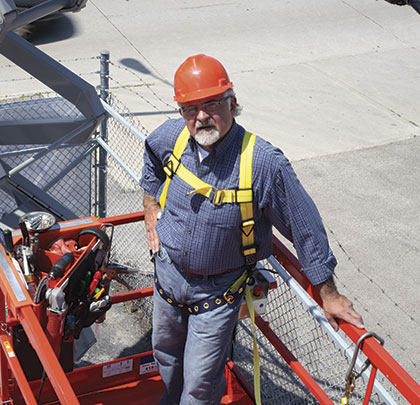Apparently workers on scaffolding are tougher than most. For them, fall protection is not required by OSHA until 10 feet (pity the poor worker who tumbles to concrete from 9 feet, 11¾ inches). For employees in general industry, the fall-protection height is 4 feet above a lower level. In construction work, the threshold height is 6 feet.
For those working on aerial lift platforms, the idea of anything falling is of major concern. The OSHA Fact Sheet-Aerial Lifts states pretty clearly that workers “Use a body harness or a restraining belt with a lanyard attached to the boom or bucket.”
Any time anyone is working from elevated heights, there are dangers. It makes no difference if working from aerial work platforms, boom lifts, scissor lifts, or vertical mast climbers, the safety and health concerns are the same.
Steven DeMore, a 34-year aerial lift veteran and president of DeMore’s Innovative Design, Inc., Menomonee Falls, Wisconsin, offers advice in three key areas:
- Know your equipment with its controls, warning signs, and signals, as well as your work surroundings.
- Never assume that what you cannot see won’t hurt you. Stop, look, and pay attention to what’s above and below; your concern for safety is equally as important for the people below as for yourself.
- Be organized. Clutter and too many items on the lift platform could create an unsafe condition, which could cause items to fall, as well as create possible tripping hazards.
Consider that every project involving aerial access equipment has three distinct phases—a pre-operation, during operation, and after operation phase with safety and health concerns for each.
PRE-OPERATION
“Inspect your work area in and out of the aerial lift—always look and think ahead,” DeMore states. “Do not become complacent, for yourself as well as your coworkers. If the young workers see the old timers concerned about lift safety, they’ll see that as the norm and be more likely to participate in good, safe aerial lift usage.”
Paying close attention to pre-use inspection of the equipment is critical. Keeping a checklist with the equipment and requiring operators to literally check off each item before signing and dating will help prevent operators from hastily using an aerial lift with mechanical problems that become apparent when it’s too late.
Most aerial access equipment manufacturers provide equipment checklists that cover everything from proper fluid levels to checking hydraulic, air, pneumatic, fuel, and electrical systems to ensuring that mechanical features and locking pins are in place—in other words, all the important details that should be looked at before operating the piece of equipment.
The OSHA Fact Sheet recommends a work zone inspection before using aerial access equipment. This inspection includes looking up to see if there are dangerous overhead hazards, such as power lines and communication cables.
The University of Kentucky provides its lift users with an “Aerial Lift Safety Program” booklet, which includes cautions about wind: Consideration shall be given to the amount of wind. Follow the manufacturer’s instruction regarding operation in windy conditions. As a general rule aerial lifts shall not be operated in winds exceeding 25 mph, although this can vary depending on the model of equipment:
- At 20 mph wind speeds or anticipated gusts, lifts will be lowered to a maximum height of 20 feet.
- At 25 mph wind speeds or anticipated gusts, lifts will be grounded.
- If at any time, personnel/staff feels unsafe, due to weather or wind conditions prior to using an aerial lift, they may make a decision to ground the lift and cease … no questions asked.
SAFE OPERATIONS
Operator safety is paramount, which means making sure that platform gates or openings are closed and that the operator does not climb or lean over guardrails or handrails. Planks, ladders, or other homemade contraptions should not be used on the work platform.
Any workers on an aerial lift platform or bucket should use a body harness or a restraining belt with a lanyard attached to the boom or bucket. Accidents happen when they are least expected, so it makes no sense to forgo these simple, required life-saving devices.
“I learned from my days working on a factory production line that if I came in and adjusted my moves enough during production, I could actually work safer and more efficiently to a point where I could work back into production those parts that the previous shift operator had set aside because they had been overwhelmed and could not keep up,” DeMore states. “I knew when I got to the construction trade and started working on aerial access equipment that safety and efficiency skills were intermixed. I discovered that working safe would transfer into efficiency.”
POST-OPERATION SHUT DOWN
When the day’s projects are completed and it’s time to descend to ground level, the shut-down process should be in mind.
Safe shutdown can begin after finding a suitable parking area, placing the platform in the stowed position, placing controls in neutral, idling the engine for gradual cooling, turning off electrical power, and taking the necessary steps to prevent unauthorized use.
The courteous operator wants to leave the equipment in the same condition they’d hope to find it the next time they work—clean, refueled, and ready to work.
“Aerial access equipment can be the best, safest way to perform work at elevated heights,” DeMore says. “Caution combined with safe practices can ensure productive use of the various types of lift equipment now available.” ■
About the Author: Jeff Winke is a business and construction writer based in Milwaukee, Wisconsin. His portfolio can be seen at jeffwinke.contently.com.
_________________________________________________________________________
Modern Contractor Solutions – January 2017
Did you enjoy this article?
Subscribe to the FREE Digital Edition of Modern Contractor Solutions magazine.



